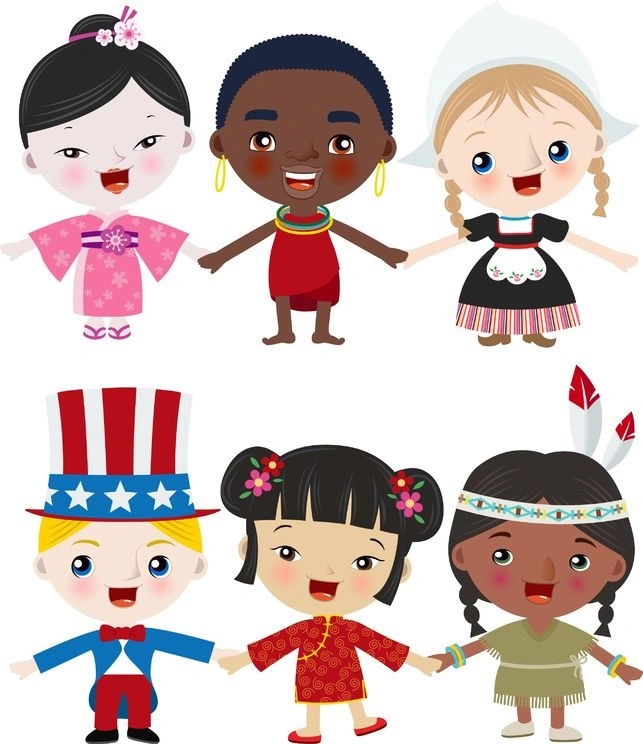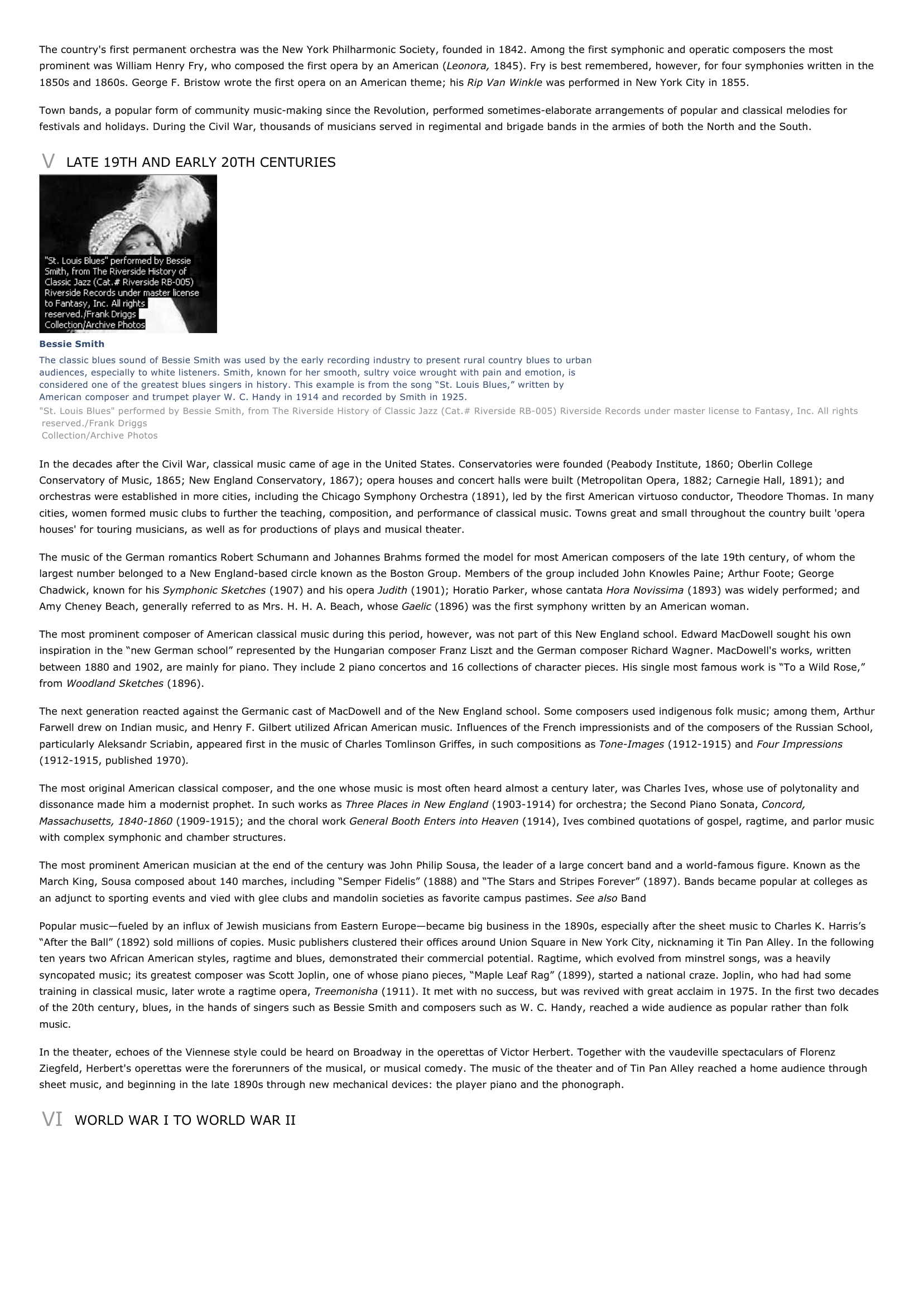American Music I INTRODUCTION American Music, the folk, popular, and classical music of the United States--created by American-born or American-trained composers, or originating in American culture, or written primarily for American audiences.
Publié le 12/05/2013

Extrait du document


«
The country's first permanent orchestra was the New York Philharmonic Society, founded in 1842.
Among the first symphonic and operatic composers the mostprominent was William Henry Fry, who composed the first opera by an American ( Leonora, 1845).
Fry is best remembered, however, for four symphonies written in the 1850s and 1860s.
George F.
Bristow wrote the first opera on an American theme; his Rip Van Winkle was performed in New York City in 1855.
Town bands, a popular form of community music-making since the Revolution, performed sometimes-elaborate arrangements of popular and classical melodies forfestivals and holidays.
During the Civil War, thousands of musicians served in regimental and brigade bands in the armies of both the North and the South.
V LATE 19TH AND EARLY 20TH CENTURIES
Bessie SmithThe classic blues sound of Bessie Smith was used by the early recording industry to present rural country blues to urbanaudiences, especially to white listeners.
Smith, known for her smooth, sultry voice wrought with pain and emotion, isconsidered one of the greatest blues singers in history.
This example is from the song “St.
Louis Blues,” written byAmerican composer and trumpet player W.
C.
Handy in 1914 and recorded by Smith in 1925."St.
Louis Blues" performed by Bessie Smith, from The Riverside History of Classic Jazz (Cat.# Riverside RB-005) Riverside Records under master license to Fantasy, Inc.
All rightsreserved./Frank DriggsCollection/Archive Photos
In the decades after the Civil War, classical music came of age in the United States.
Conservatories were founded (Peabody Institute, 1860; Oberlin CollegeConservatory of Music, 1865; New England Conservatory, 1867); opera houses and concert halls were built (Metropolitan Opera, 1882; Carnegie Hall, 1891); andorchestras were established in more cities, including the Chicago Symphony Orchestra (1891), led by the first American virtuoso conductor, Theodore Thomas.
In manycities, women formed music clubs to further the teaching, composition, and performance of classical music.
Towns great and small throughout the country built 'operahouses' for touring musicians, as well as for productions of plays and musical theater.
The music of the German romantics Robert Schumann and Johannes Brahms formed the model for most American composers of the late 19th century, of whom thelargest number belonged to a New England-based circle known as the Boston Group.
Members of the group included John Knowles Paine; Arthur Foote; GeorgeChadwick, known for his Symphonic Sketches (1907) and his opera Judith (1901); Horatio Parker, whose cantata Hora Novissima (1893) was widely performed; and Amy Cheney Beach, generally referred to as Mrs.
H.
H.
A.
Beach, whose Gaelic (1896) was the first symphony written by an American woman.
The most prominent composer of American classical music during this period, however, was not part of this New England school.
Edward MacDowell sought his owninspiration in the “new German school” represented by the Hungarian composer Franz Liszt and the German composer Richard Wagner.
MacDowell's works, writtenbetween 1880 and 1902, are mainly for piano.
They include 2 piano concertos and 16 collections of character pieces.
His single most famous work is “To a Wild Rose,”from Woodland Sketches (1896).
The next generation reacted against the Germanic cast of MacDowell and of the New England school.
Some composers used indigenous folk music; among them, ArthurFarwell drew on Indian music, and Henry F.
Gilbert utilized African American music.
Influences of the French impressionists and of the composers of the Russian School,particularly Aleksandr Scriabin, appeared first in the music of Charles Tomlinson Griffes, in such compositions as Tone-Images (1912-1915) and Four Impressions (1912-1915, published 1970) .
The most original American classical composer, and the one whose music is most often heard almost a century later, was Charles Ives, whose use of polytonality anddissonance made him a modernist prophet.
In such works as Three Places in New England (1903-1914) for orchestra; the Second Piano Sonata, Concord, Massachusetts, 1840-1860 (1909-1915); and the choral work General Booth Enters into Heaven (1914), Ives combined quotations of gospel, ragtime, and parlor music with complex symphonic and chamber structures.
The most prominent American musician at the end of the century was John Philip Sousa, the leader of a large concert band and a world-famous figure.
Known as theMarch King, Sousa composed about 140 marches, including “Semper Fidelis” (1888) and “The Stars and Stripes Forever” (1897).
Bands became popular at colleges asan adjunct to sporting events and vied with glee clubs and mandolin societies as favorite campus pastimes.
See also Band
Popular music—fueled by an influx of Jewish musicians from Eastern Europe—became big business in the 1890s, especially after the sheet music to Charles K.
Harris’s“After the Ball” (1892) sold millions of copies.
Music publishers clustered their offices around Union Square in New York City, nicknaming it Tin Pan Alley.
In the followingten years two African American styles, ragtime and blues, demonstrated their commercial potential.
Ragtime, which evolved from minstrel songs, was a heavilysyncopated music; its greatest composer was Scott Joplin, one of whose piano pieces, “Maple Leaf Rag” (1899), started a national craze.
Joplin, who had had sometraining in classical music, later wrote a ragtime opera, Treemonisha (1911).
It met with no success, but was revived with great acclaim in 1975.
In the first two decades of the 20th century, blues, in the hands of singers such as Bessie Smith and composers such as W.
C.
Handy, reached a wide audience as popular rather than folkmusic.
In the theater, echoes of the Viennese style could be heard on Broadway in the operettas of Victor Herbert.
Together with the vaudeville spectaculars of FlorenzZiegfeld, Herbert's operettas were the forerunners of the musical, or musical comedy.
The music of the theater and of Tin Pan Alley reached a home audience throughsheet music, and beginning in the late 1890s through new mechanical devices: the player piano and the phonograph.
VI WORLD WAR I TO WORLD WAR II.
»
↓↓↓ APERÇU DU DOCUMENT ↓↓↓
Liens utiles
- George Frideric Handel I INTRODUCTION Handel's Water Music In addition to his popular operas and oratorios, German-born composer George Frideric Handel wrote music in the 1700s for the church and for royal celebrations.
- Diana Ross Diana Ross, born in 1944, American popular singer, one of the most influential recording artists of the Motown era (1960s) and the disco period of rhythm-and-blues (R&B) music (late 1970s to early 1980s).
- Bob Dylan Bob Dylan, born in 1941, American musician and songwriter, one of the most important figures in contemporary folk music and rock music.
- Marvin Gaye Marvin Gaye (1939-1984), American singer and songwriter, a recording artist for Motown Records, and one of the most popular and influential singers of rhythm-andblues music (R&B) in the 1960s and 1970s.
- Popular Music I INTRODUCTION Satchmo Sings "Back O' Town Blues" One of the founders of instrumental jazz music, American Louis Armstrong, known as Satchmo, also profoundly influenced vocal jazz and popular song.

































